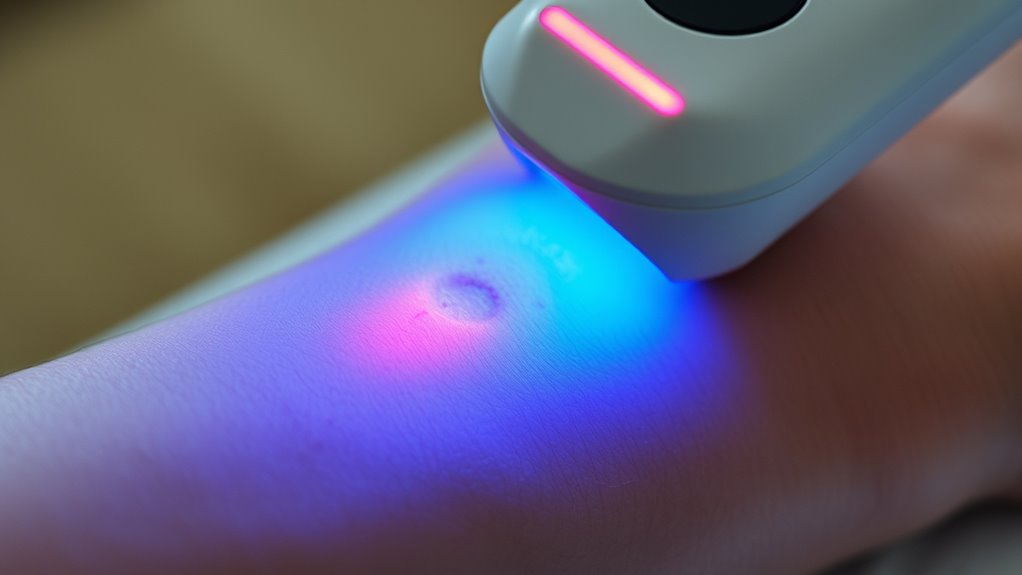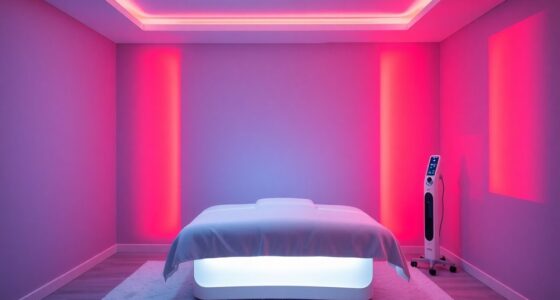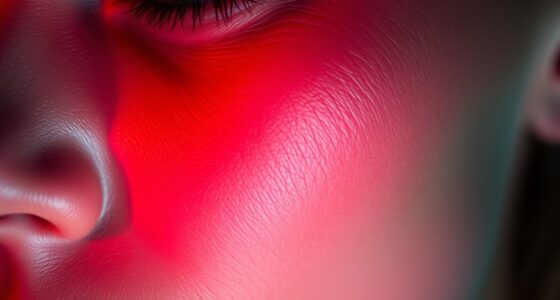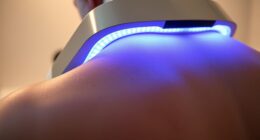Current research shows that photobiomodulation uses specific light wavelengths to boost your body’s natural healing processes. It stimulates cellular activity by interacting with mitochondria, increasing ATP production, and accelerating tissue repair. This non-invasive therapy promotes faster wound closure, improves tissue strength, and reduces scarring. It’s safe, well-tolerated, and minimizes recovery time. To learn how this innovative approach could support your healing, consider exploring the latest findings in this promising field.
Key Takeaways
- Current research demonstrates photobiomodulation accelerates wound healing by stimulating cellular proliferation and tissue regeneration.
- Studies show effective wavelengths and dosages optimize healing outcomes and minimize side effects.
- Evidence supports improved collagen synthesis, blood vessel formation, and reduced inflammation with photobiomodulation therapy.
- Recent trials highlight its role as a safe, non-invasive adjunct to conventional wound care practices.
- Ongoing research explores novel applications and mechanisms to enhance wound repair efficiency further.

Photobiomodulation, also known as low-level laser therapy, is an innovative technique that uses specific wavelengths of light to accelerate wound healing. When you undergo this therapy, you’re applying targeted laser therapy to the affected area, stimulating cellular processes that promote repair and recovery. This approach harnesses the power of light to influence biological functions at the cellular level, making it a promising option for enhancing wound healing outcomes.
Photobiomodulation uses targeted light to stimulate cellular repair and accelerate wound healing effectively.
The core mechanism behind photobiomodulation involves stimulating cell regeneration. When the laser light penetrates the tissue, it interacts with mitochondria, the energy powerhouses within your cells. This interaction boosts the production of adenosine triphosphate (ATP), which provides the energy necessary for cells to perform their functions more efficiently. As a result, your body’s natural healing processes are accelerated, leading to faster tissue repair and reduced healing times. You might notice that wounds close more quickly and with less discomfort when laser therapy is incorporated into your treatment plan.
Laser therapy’s ability to promote cell regeneration extends beyond just speeding up healing; it also improves the quality of the tissue that forms. By encouraging the proliferation of new cells and supporting the formation of healthy blood vessels, laser therapy ensures that the new tissue is robust and functional. This process helps minimize scarring and enhances the overall appearance and strength of the healed area. As you receive laser treatments, the therapy’s influence on cellular activity helps restore damaged tissues more effectively than traditional methods alone.
Furthermore, laser therapy is non-invasive and generally well-tolerated, making it a safe adjunct for wound care. You don’t have to worry about significant side effects or downtime, which means you can continue your daily activities with minimal interruption. The precise targeting of the laser ensures that only the affected tissues are stimulated, reducing the risk of damage to surrounding healthy tissues. This specificity not only improves healing efficiency but also provides a comfortable experience during each session.
Frequently Asked Questions
What Are the Long-Term Effects of Photobiomodulation Therapy?
You might wonder about long-term safety and sustained efficacy. Current evidence suggests that photobiomodulation therapy has minimal adverse effects over time, making it generally safe for repeated use. Its sustained efficacy in promoting wound healing continues to be supported by ongoing research. However, long-term studies are still limited, so maintaining regular monitoring guarantees you benefit from its safe, effective application without unforeseen risks.
How Does Wound Type Influence Treatment Outcomes?
You see that wound classification, whether it’s a clean surgical cut or a chronic ulcer, directly influences your treatment outcomes. Different wound types demand tailored approaches—what works for a superficial scrape may not suit a deep pressure ulcer. By customizing your treatment based on wound classification, you enhance healing, reduce complications, and optimize recovery. Understanding wound type empowers you to select the most effective photobiomodulation strategies for each unique case.
Are There Any Contraindications for Using Photobiomodulation?
You should know that there are some safety concerns with photobiomodulation, especially regarding patient selection. Avoid using it on patients with active malignancies, pregnant women, or those with photosensitive conditions, as these can pose contraindications. Always evaluate individual health profiles and consult guidelines to guarantee safe application, minimizing risks and optimizing treatment outcomes. Proper screening helps you deliver effective, safe wound care with photobiomodulation.
How Does Photobiomodulation Compare to Traditional Wound Care Methods?
Think of photobiomodulation as a gentle boost, like a morning coffee for your wounds. It often accelerates healing faster than traditional methods, offering a promising alternative that minimizes discomfort and scarring. Patients tend to report higher satisfaction because it’s less invasive and more natural. While conventional care relies on dressings and antibiotics, this innovative approach adds a new layer of hope, making recovery smoother and more personalized.
What Are the Cost Implications of Implementing Photobiomodulation Therapy?
Implementing photobiomodulation therapy can have higher initial therapy costs due to equipment expenses, but it may reduce overall wound care costs by speeding up healing and decreasing complications. You might see savings in fewer dressing changes and shorter treatment durations. While equipment expenses are a consideration, the potential for faster recovery and improved outcomes can make therapy costs worthwhile in the long run.
Conclusion
As you explore the potential of photobiomodulation, consider it a beacon guiding wounds toward healing. Its ability to stimulate cellular activity and accelerate recovery offers hope where traditional treatments fall short. While research continues, embracing this innovative approach feels like opening a door to a brighter, faster healing future. Don’t overlook the power of light—sometimes, it’s all it takes to transform despair into recovery and turn wounds into stories of resilience.







